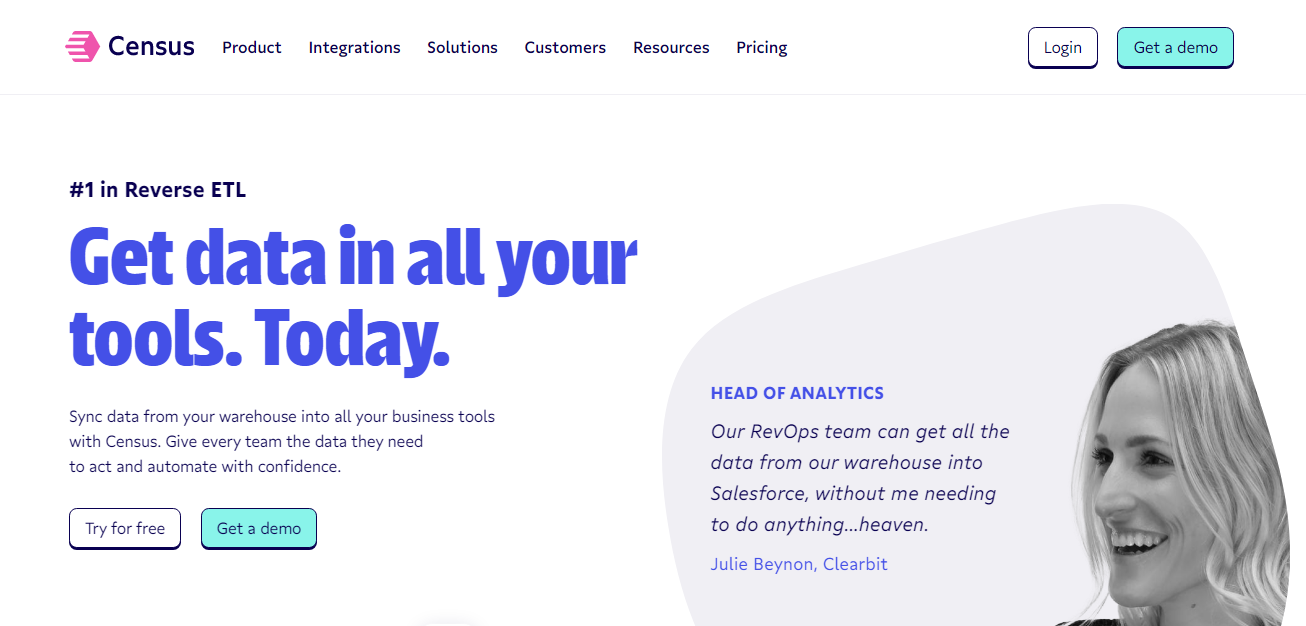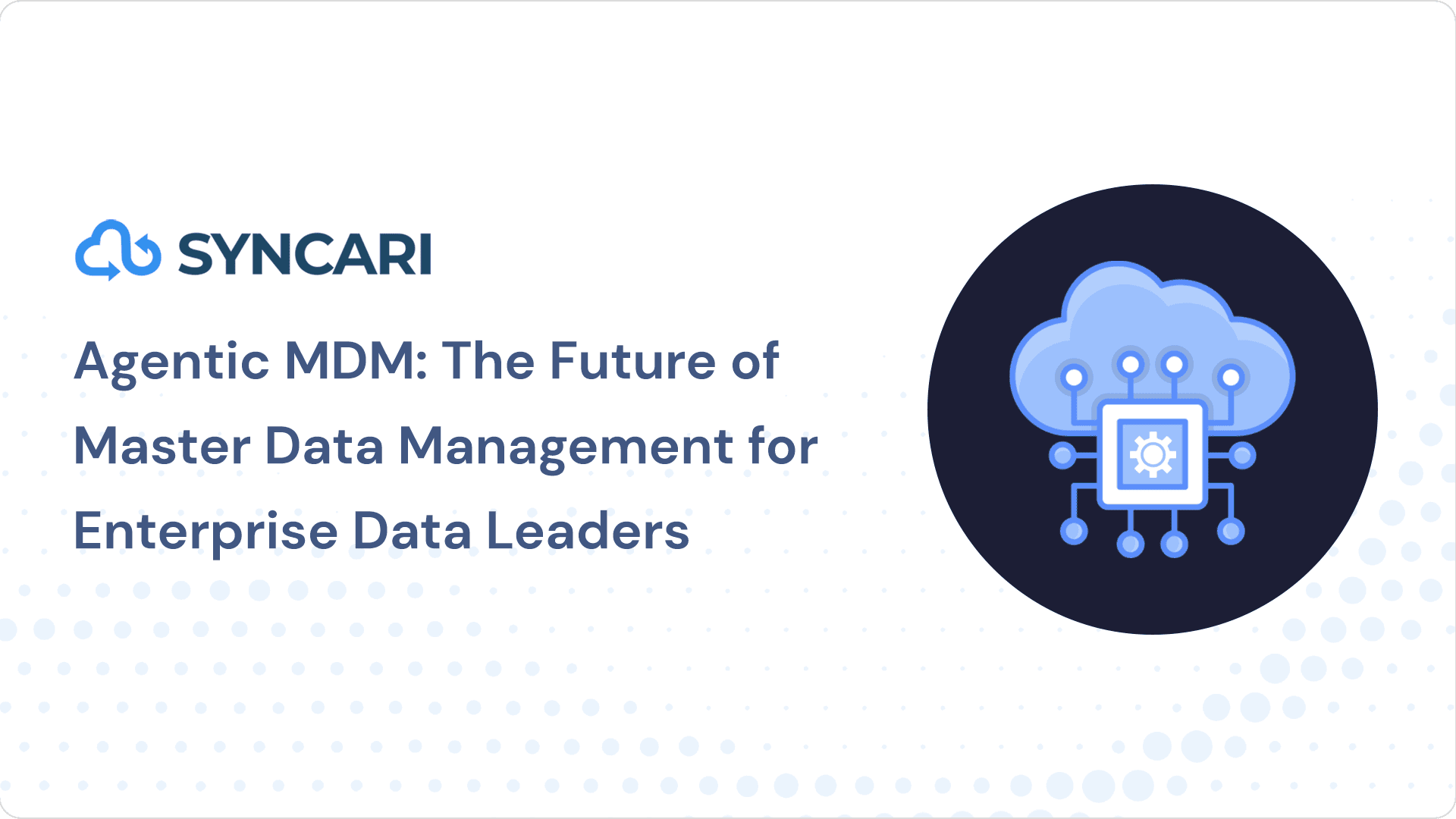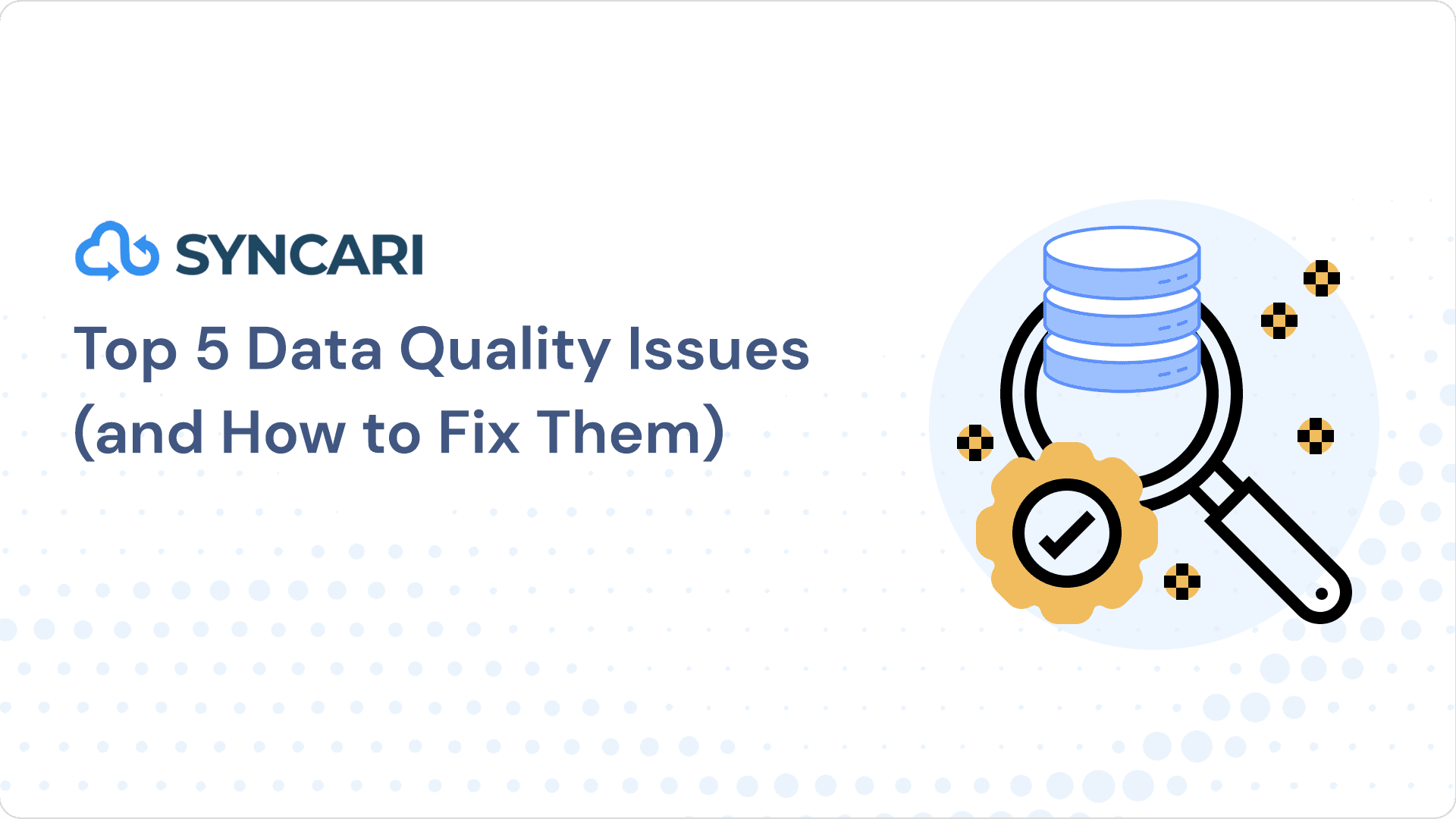With the aid of Census, users may synchronize data from their database with all their business apps for operational analytics. The information needed to improve functionality, workflows confidently, and other processes are provided to the business team. The software allows users to obtain data on a large scale while preventing fraudulent and stolen actions.
Organizations may focus on having worthwhile conversations with leads while also creating scoring models for each lead with the help of the software. It incites marketers to design highly tailored programs for use across a variety of marketing channels.
The program makes their tasks easier by enabling data analysts to handle all of their viewers’ sectors on a single platform. Analysts of census data can even do tests independently without consulting engineers.
Additionally, data teams might distribute data to stakeholders fast and devote more effort to creating customized integrations that maximize value. Reducing risks and offering quicker customer service also aids in the success of the client.
In this article, we will outline Census pricing, key features, benefits, and drawbacks and discuss how it compares to other alternatives in the market.
What Is GetCensus?
Census is a reliable reverse ETL operational analytics platform. Copying data from a warehouse into company applications like CRM, analytics, and marketing automation software is known as reverse ETL. A reverse ETL solution that integrates with your data source and business tools is used to carry out this operation.
“Extract, transform, and load,” or “ETL,” is the process of extracting data from a source, cleaning and structuring it, and transferring it to a data warehouse or data lake. This procedure is known as “reverse ETL.” ELT is the process of loading data before altering it.
A vital element of the current data stack is a reverse ETL tool. Implementing reverse ETL will benefit all business teams and departments.
Every team can take action on the reliable data that Census feeds from the warehouse into your operational tools. Operational analytics can boost automation, processes, and personalization without special engineering considerations or customized scripts.
By integrating the data warehouse with CRM and go-to-market tools and putting customer success, sales, and marketing teams on the same page by sharing the same customer data, the company’s platform enables client businesses to utilize and disseminate product data where required.
Defining Features
You can access all your data in one location because Census works on top of your current warehouse. To ensure that every team uses the same data to accomplish their objectives after your models have been defined in Census, you can sync them to all the tools.
Census allows you to follow through on the promise of being “data-driven” by transferring what the analytics team performs from static dashboards to tools the rest of the company uses.
The platform automatically handles API errors, and continuous monitoring informs you of potential catastrophes. Additionally, it enables rapid batch updates with incremental sync.
Some of the key features of Census that can significantly improve your workflow are:
Automatic Triggers
Set up automatic notifications in Microsoft Teams or Slack to receive real-time updates on client action. In our feature-rich visual builder, you can create your message content using fields from your data warehouse.
SQL Model Editor and Builder
Request information from any data warehouse resource, create robust filters or modify the data. Simply type SQL, check the outcomes, and save. You do not require any custom code or script to be able to do it.
Various Sync Behaviors
Every sync is unique. Census modes can assist you in syncing the precise data, whether you need to generate new leads in SFDC or update an account with their PQL score (Enrich, Mirror, Upsert, or Create).
Automatic Restoration
Census will send you an email to let you know if it loses contact with any databases or apps, and the sync will begin again once it does. Your stack maintains synchronization, and you never lose data.
Reports on Daily Data Trends
With daily & weekly reports that indicate trends in errors, skipped, produced, or changed records, they make it simple to maintain and keep an eye on your sync.
Converting your Column’s Type to Fields
Census automatically converts field kinds. It automatically handles the conversion for you if you save “deal size” as an integer in your warehouse and a string in Salesforce.
API for Data Orchestration
Utilizing solutions like Airflow, Dagster, DBT Cloud, and others, trigger synchronization occurs precisely when you want it to.
Data Visualization Tool
Census makes it simple to set up how data is mapped into your target tools, from Leads to Custom Objects. To maintain continuous data flow, it handles all the translation details.
Continuous & Scheduled Sync
How often data is synchronized can be adjusted. You can select schedules for various syncs, from real-time to monthly or manual.
Improve API Calls
Simply because your team needs more data shouldn’t require you to exceed your Salesforce API quota. Census only syncs records with pending changes and makes use of bulk APIs.
Assistance for DBT
To fully utilize your data, keep creating DBT models and use Census to operationalize the data across your systems.
Comprehensive Observability & Logging
Every sync includes a history log so you may explore what went wrong or why a particular application rejected updates.
Census Pricing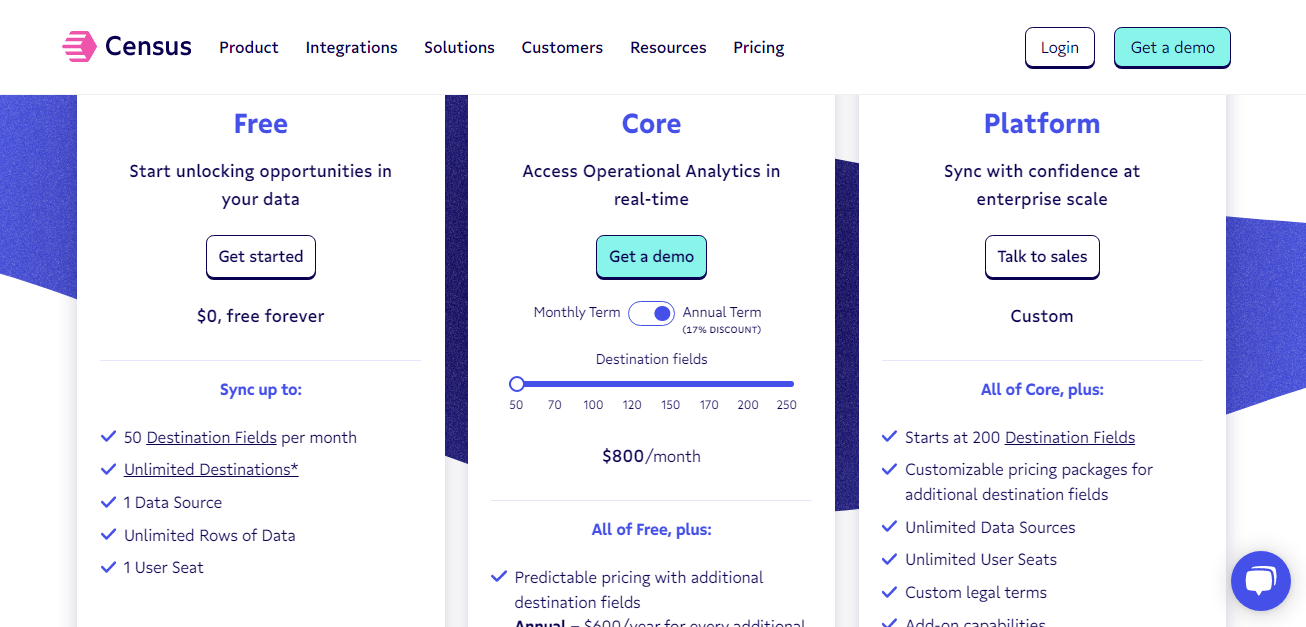
Pricing criteria includes
- Annual contracts: ASP ~$8k-$10k
- No charge for the size of a data set
- 14-day free trial
- Startups with fewer than 40 people can pay $100/per month
Census is deemed one of the best options when it comes to their pricing. Depending on your business and workflow integrations, they charge affordable prices for various packages.
Thoroughly research and compare with other platforms before choosing the right package for your company. Check out the Census website for further information on their pricing.
Benefits And Drawbacks Of Census
Benefits
Some significant benefits of using Census include the following:
- Query Builder is absurdly easy to use. Census can be used if you are familiar with SQL; no custom code is required.
- It is SOC2, GDPR, and CCPA compliant.
- According to some, the “missing element” of the current data stack is getting data back to operational systems. Census removes a clear annoyance if you already use FiveTran and Snowflake as a customer.
Drawbacks
Here are some of the drawbacks users have mentioned:
- Census procedures become unusable when data models, schemas in operational systems, or the data warehouse change.
- The sync log terminates at the data warehouse, omitting the complete data lineage.
- Normalization of data in a warehouse is a prerequisite, which calls for ELT (FiveTran) + Transformation (DBT).
Best Alternative to Getcensus
Though Census is one of the top players in the market, there are a few drawbacks to using it, which can easily be deflected using similar alternatives. If you are looking for such a platform, Syncari is an excellent alternative. 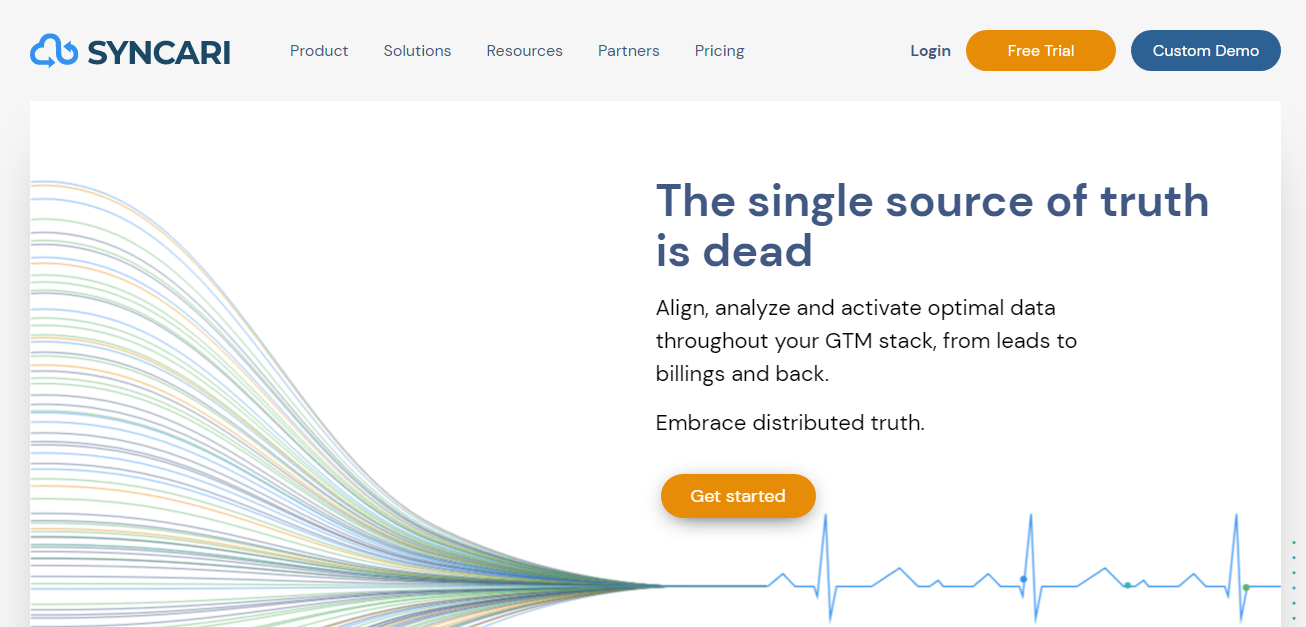
Syncari is a similar platform to Census, with some extra features that make it a better option than Census. Operations experts can unify, clean, manage, and disseminate trusted customer data across the company with the help of Syncari’s data automation platform. With a potent combination of data management, workflow automation, and multi-directional sync, Syncari restores data trust.
Key differentiating features of Syncari are:
- Unlocks interoperability
- Unified data model
- Intelligent Synapses
- Resilient, multi-directional sync
- Distributed governance
- Auditable transaction log
- Complete platform
- Data integration and unification
- Data management
- Workflow automation
- Fully managed operational data hub
- Extensibility to BI tools
FAQ
What is Census ETL?
Census creates what is referred to as a reverse ETL platform. Data is put into a data warehouse using standard ETL (extract, transform, and load), which can be used for data analytics.
What is reverse ETL?
To operationalize data, reverse ETL is the process of synchronizing data from a source of truth, such as a data warehouse, to a system of actions, such as a CRM, advertising platform, or other SaaS software.
Bottom Line
Census is an integration tool that enables you to access customer information locked in other applications or databases from your sales and marketing tools. If you want to improve your company’s workflow and get the best results, incorporating Census into your system is an option you should consider.
For further improvement, use Syncari. It will make the entire process much more seamless by allowing you to access more functionalities for business improvement.
Whether you choose to use Census or Syncari, your business will do better once you properly utilize their features.
